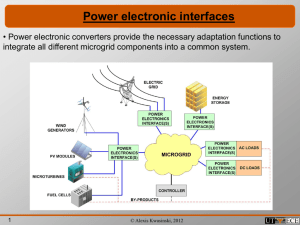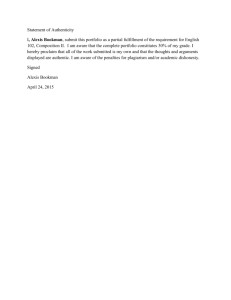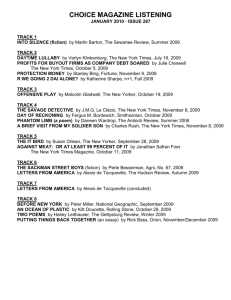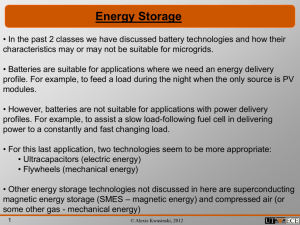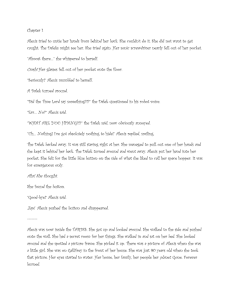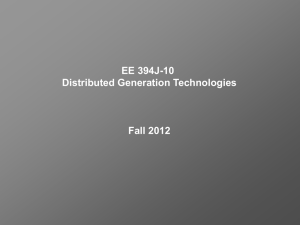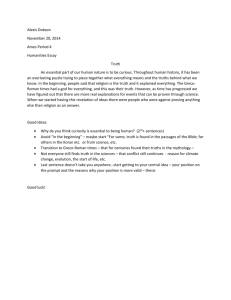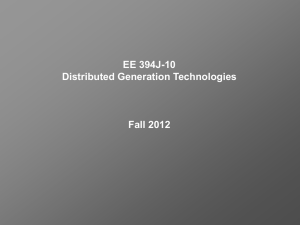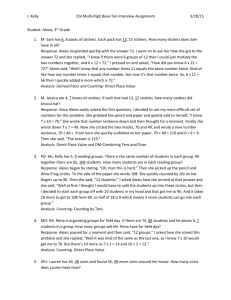Microturbines and other combustion technologies
advertisement
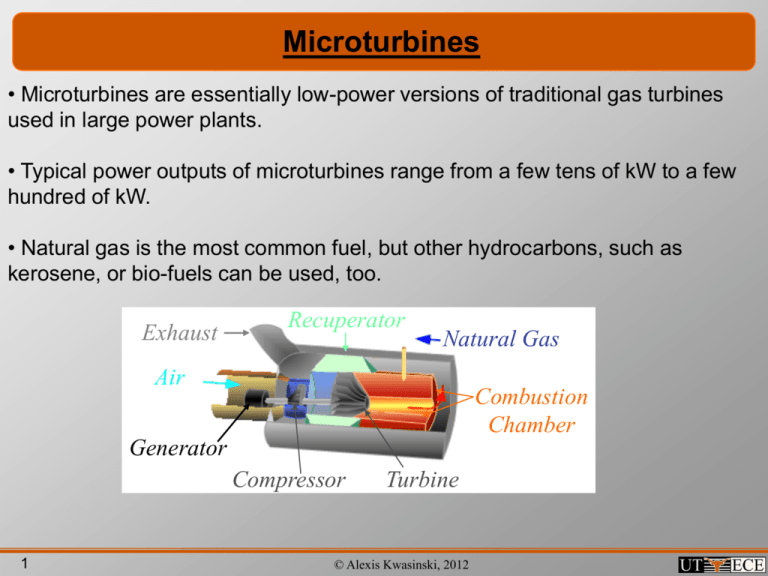
Microturbines • Microturbines are essentially low-power versions of traditional gas turbines used in large power plants. • Typical power outputs of microturbines range from a few tens of kW to a few hundred of kW. • Natural gas is the most common fuel, but other hydrocarbons, such as kerosene, or bio-fuels can be used, too. Exhaust Recuperator Natural Gas Air Combustion Chamber Generator Compressor 1 Turbine © Alexis Kwasinski, 2012 Microturbines Capstone 30 kW and 60 kW units Ingersoll 70 kW Induction microturbine 250 kW synchronous microturbine Wilson TurboPower 300 kW Mariah Energy 30 kW and 60 kW units 2 © Alexis Kwasinski, 2012 Microturbines • Moderate cost and efficiency • High-frequency output is rectified (and inverted again in ac microgrids). Generator output frequency is in the order of a few kHz (e.g. 1600 Hz for Capstone’s 30 kW microturbine). • Power shaft rotates at high speeds, usually on the order of 50 000 to 120 000 rpm • Very reliable technology (Essentially microturbines are aircraft’s APU’s). Critical parts: bearings and generator. • Generator technologies: Synchronous and permanent magnet • Moderately fast dynamic response 3 © Alexis Kwasinski, 2012 Microturbines http://www.energy.ca.gov/distgen/equipment/microturbines/microturbines.html Oak Ridge National Laboratory; ORNL/TM-2003/74 4 © Alexis Kwasinski, 2012 Thermodynamics: Review from week 1 Entropy: it is a property that indicates the disorder of a system or how much reversible is a process. This last definition relates entropy to energy “quality”. • In a reversible isothermal process involving a heat transfer Qrev at a temperature T0, the entropy is defined as Q S rev T0 In all processes involving energy conversion or interactions ΔS is nonnegative. ΔS is zero only in reversible processes. Q • For any process then S T • The “=“ in the above relationship will give us the minimum amount of heat Qmin required in a process. 5 © Alexis Kwasinski, 2012 Carnot Cycle • Thermodynamic cycle for heat engines • Describes the thermodynamic energy conversion process for the most efficient heat engine. • The cycle has 4 states. • Q1 is the heat (i.e., energy) provided to the Carnot engine • Q2 is the heat that the engine returns to the environment (heat rejection) • W is the work (i.e., energy) produced in one cycle • Without losses W = Q1 - Q 2 •The power produced by the engine is P = W.(cycles per second) 6 © Alexis Kwasinski, 2012 Carnot Cycle • From the definition of “work”: F dA.dl PdV C dA C W Fdl C • If the curve is closed (a cycle), then W 7 PdV © Alexis Kwasinski, 2012 Carnot Cycle • But in a lossless process: W = Q1 - Q2 • Since dS Q T then, Q TdS S2 S4 1 3 Thus, W Q1 Q2 S T1dS S T2 dS So W Q1 Q2 (T1 T2 )(S2 S1 ) 8 © Alexis Kwasinski, 2012 Carnot Cycle • So W Q1 Q2 (T1 T2 )(S2 S1 ) • The efficiency is W Q1 Hence, (T1 T2 )( S2 S1 ) T 1 2 T1 ( S2 S1 ) T1 • Observation #1: The efficiency increases as T1 increases (higher quality heat) and T2 (typically the ambient temperature) decreases. • Observation #2: Since T2 can never be zero, the efficiency can never be 1. • Observation #3: Stirling engines operation approximates a Carnot Cycle. 9 © Alexis Kwasinski, 2012 Brayton Cycle • Gas turbines operation follow a Brayton cycle 4 1 2 10 © Alexis Kwasinski, 2012 3 Brayton Cycle • We already know that W Q1 Q2 • Thus, the efficiency is Q2 W Q1 Q2 1 Q1 Q1 Q1 Since heat injection and rejection occur at constant pressure then, Q1 c p (T3 T2 ) Q2 c p (T1 T4 ) • Hence, the efficiency is T T1 4 1 c p (T4 T1 ) T1 Q2 1 1 1 Q1 c p (T3 T2 ) T3 T2 1 T2 11 © Alexis Kwasinski, 2012 Brayton Cycle • Between 1 and 2, and between 3 and 4, the process is adiabatic (no heat exchange) and reversible (S is constant). Hence, the temperature changes due to work related with a pressure change acting on a varying volume. • In a reversible adiabatic process: PV . constant and P 1T constant where • Hence, • Therefore 12 cp cv PV PV PV PV 1 1 2 2 3 2 4 1 P4 V2 P1 P3 V1 P2 © Alexis Kwasinski, 2012 Brayton Cycle • From the previous slide: P4 P1 P3 P2 •Also, from the previous slide P 1T constant • Thus, T4 T1 T3 T2 13 © Alexis Kwasinski, 2012 Brayton Cycle •Since the efficiency is (see a couple of slides ago) T4 T1 1 c ( T T ) T1 Q2 p 4 1 1 1 1 Q1 c p (T3 T2 ) T T2 3 1 T2 • Then the simplified expression for the efficiency is 1 T1 T2 • Usually, the efficiency is expressed in terms of the temperature ratio (TR) or the pressure ratio (PR) 1 1 1 1 (TR ) ( PR)( 1) / where (TR) 14 T2 P and ( PR) 2 T1 P1 © Alexis Kwasinski, 2012 Microturbine characteristics • The efficiency is improved if T2 is increased. The recuperator is used for that purpose. Other ways of preheating the air before the combustion stage could be to use heat from a fuel cell. • The efficiency decreases as the input temperature increases: Ingersoll 70L datasheet 15 Capstone C30 datasheet © Alexis Kwasinski, 2012 Reciprocating engines • This is likely the most common DG technology. • Some types of reciprocating engines are the internal combustion engines and the Stirling engines. • Types of internal combustion engines: • Spark ignition (fuel: natural gas) • Compression ignition (fuel: diesel) • The engines are used to drive synchronous or permanent magnet generators. http://www.energy.ca.gov/distgen/equipment/reciprocating_engines/reciprocating_engines.html 16 © Alexis Kwasinski, 2012 Reciprocating engines • A recent example involved using reciprocating engines as DG units to provide temporary power to Port Bolivar, TX after Ike. Transmission line between Winnie and Port Bolivar 17 © Alexis Kwasinski, 2012 Spark Ignition engines • Natural gas is the most commonly used fuel. • Thermodynamically they follow an Otto cycle with 4 strokes: • 1. intake (induction) stroke • 2. compression stroke • 3. power stroke: combustion/expansion • 4. exhaust stroke • Efficiency: 1 1 r 1 r is the compression ratio V1/V2 http://en.wikipedia.org/wiki/Imag e:4-Stroke-Engine.gif#file 18 © Alexis Kwasinski, 2012 Compression Ignition engines • Natural gas is the most commonly used fuel. • Thermodynamically they follow a Diesel cycle • 1. intake (induction) stroke • 2. compression stroke • 3. power stroke • 4. expansion stroke 1 1 • Efficiency: 1 r 1 ( 1) r is the compression ratio V1/V2 and α is the ratio V3/V2 http://library.thinkquest.org/C006 011/english/sites/diesel.php3?v=2 More animated engines: http://library.thinkquest.org/C006 011/english/sites/animations.php3 ?v=2 19 © Alexis Kwasinski, 2012 Emissions comparison http://www.raponline.org/ProjDocs/DREmsRul/Collfile/DGEmissionsMay2001.pdf 20 © Alexis Kwasinski, 2012 DG technologies comparison Resource Dynamics Corporation, “Assessment of Distributed Generation Technology Applications”, Feb. 2001 21 © Alexis Kwasinski, 2012
